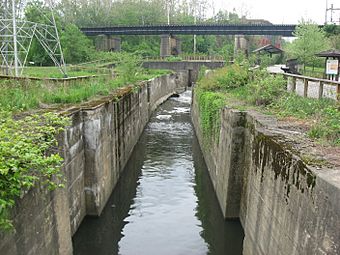Cascade Locks Historic District facts for kids
Quick facts for kids |
|
|
Cascade Locks Historic District
|
|

Lock 14
|
|
| Location | Roughly bounded by North, Howard, Innerbelt Route 59 and the canal from Locks 10 to 15, including discontiguous parts N, Akron, Ohio |
|---|---|
| Area | 25 acres (10 ha) |
| Built | 1827 |
| Architectural style | Chicago, Greek Revival, The Commercial Style |
| NRHP reference No. | 92001627 |
| Added to NRHP | December 10, 1992 |
The Cascade Locks Historic District is a special historical area in Akron, Ohio. It was added to the National Register of Historic Places in 1992. This means it's an important place recognized for its history and unique features.
Contents
Exploring the Cascade Locks Historic District
The Cascade Locks Historic District is a cool spot located just northwest of downtown Akron. Imagine a deep valley that opens up to a flat area. This is where the old Ohio and Erie Canal used to meet the Little Cuyahoga River. This part of the canal was the steepest section of its entire 304-mile journey from Lake Erie to the Ohio River.
A Busy Waterway and Industrial Hub
In the 1800s and early 1900s, this district was a very busy place. Many factories and businesses were built here. They used the strong water power from the steep drop of the canal and a nearby stream called Crosby's Mill Race. The canal wasn't just for moving goods; it also created lots of traffic and opportunities for trade.
- Locks and Travel: The canal had special sections called "locks." These were like water elevators that helped boats move up or down hills. In the Akron area, there were 21 locks! It took boats about six hours to get through just two miles of the canal. This long wait meant that canal travelers often stopped and explored the area.
- The Mustill Store: A very popular spot for canal workers and travelers was the Mustill Store. It was located right across from Lock 15. Even though it started as a cigar box factory, it became well-known as a place where people could relax and get refreshments. Today, the Mustill Store is a visitor center and a museum about the canal.
The Big Flood of 1913
The year 1913 brought a huge flood that changed everything for the canal. To stop the downtown area from being completely flooded, several locks were intentionally blown up with dynamite. The Cascade Locks area was one of the most damaged parts of the canal system. After the flood, officials decided the canal couldn't be fixed.
Today, water from Summit Lake is managed by a special dam system at Lock 1. This helps prevent another disaster like the 1913 flood. The water now flows freely over the old locks and into the Little Cuyahoga River.
What You Can See Today
The Cascade Locks Historic District is full of interesting things to see, including:
- The historic Mustill Store, which is now a museum.
- The original sites of mills owned by Ferdinand Schumacher, who founded the famous Quaker Oats Company.
- Two old railroad bridges that cross the valley.
- Remains of a steam plant and two rubber factories.
- Many ruins of the old locks and waterways.
A walking path now runs right alongside the old locks. There's also a hike and bike trail called the Ohio and Erie Canal Towpath. This trail connects the Cascade Lock Park all the way from Cuyahoga County, Ohio to the southern part of Akron in Summit County, Ohio. It's a great way to explore the history and natural beauty of the area!



